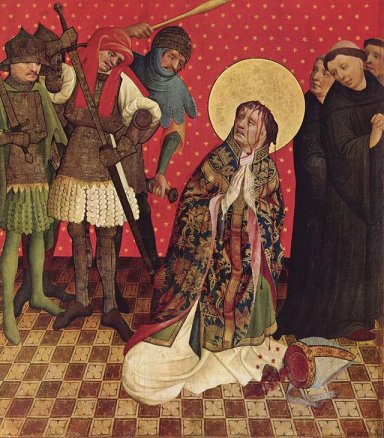Thomas Becket, St Thomas of Canterbury, is unique amongst British saints. His reputation, and images of him, have spread widely. Frescos of Thomas can be found in Italy, Germany, and Spain. The image below comes from the Thomas altarpiece by Meister Francke, now in the Kunsthalle Museum in Hamburg.
So why did this happen? One key aspect of the story of Becket is his martyrdom. Martyred saints had a special power and prominence in the Christian church, but by the twelfth century those who died for their faith were mainly heretics. In England there were a number of child saints supposedly murdered by Jews such as Hugh of Lincoln, but these cults soon died out, as the stories were by and large recognised as medieval fake news. The closest parallel with Becket is the martyrdom of Charles I in Bruges in 1127; however, Charles wasn’t beatified until 1882.
Another aspect was the liturgical symbolism of the martyrdom: a holy person, shedding his blood in a sacred place. A wall painting we will look at later, from a medieval church in Brighton, shows Becket murdered at an altar, on which stands a chalice.
Why did the cult of Thomas become so important? Cynics would say that the ecclesiastical authorities welcomed the opportunity to make a great deal of money from the pilgrim trade, and that the many accounts of miracles at Becket’s tomb were another example of medieval fake news. Genuine or not, the Thomas cult became an important part of the Christian story, and, as we will see, inspired some splendid art. And not just art: From the Canterbury Tales to T S Eliot’s Murder in the Cathedral the story of Becket is a significant element in the English literary tradition.
A brief note: Becket is frequently known as Thomas à Becket

The story of Becket’s life is a familiar one and I won’t go into lengthy detail here. He was clearly an able young man and worked for the then Archbishop of Canterbury, Theobald of Bec, who entrusted him with various missions abroad, and appointed him to various secular roles in church governance. His talents in these offices led Theobald to recommend him to the king for the post of Lord Chancellor; he was appointed in 1155. In this role he was highly valued by the king, Henry II.
In 1162 Thomas was nominated for the then vacant position of Archbishop of Canterbury. He was ordained priest on the second of June, and consecrated archbishop the next day – a rapid promotion!
The battles between Thomas and the king then commenced. It seems that Henry thought Thomas would be a pushover when it came to the monarch’s rights over the Church – Thomas had been on the king’s side up to now - but this was not so. There then followed eight years of strife. Most of the English bishops were prepared to meekly roll over to the king’s demands on clergy privilege and church money, but not Becket.
Why did Becket not give in to the king? The usual line is that, on becoming archbishop, Thomas discovered his true self, and began a life of asceticism and devotion to the church. Others say he was only interested in building his own power base. Whichever is true, he spent most of the years of his archbishopric in exile, despite the efforts of the pope to build a compromise. Following a patched-up deal, Becket returned to Canterbury in 1170, but immediately offended Henry by excommunicating the bishops (and York’s archbishop) who had officiated at the crowning of the heir apparent. That was The Archbishop of Canterbury’s job.
There followed the legendary tale of the initiation of Becket’s murder. The king is said to have said, ‘Who will rid me of this turbulent priest?’, which was overheard by four knights, Reginald FitzUrse, Hugh de Morville, William de Tracy and Richard le Breton, who took him at his word, and set off to do the deed at Canterbury. How near all this is to the truth is impossible to tell.
Page 3 - The stained glass
Page 4 - Medieval manuscripts
Page 5 - Images in English churches
Page 7 - Pilgrimage tokens
Page 8 Where is he now?
Home page - explore the site